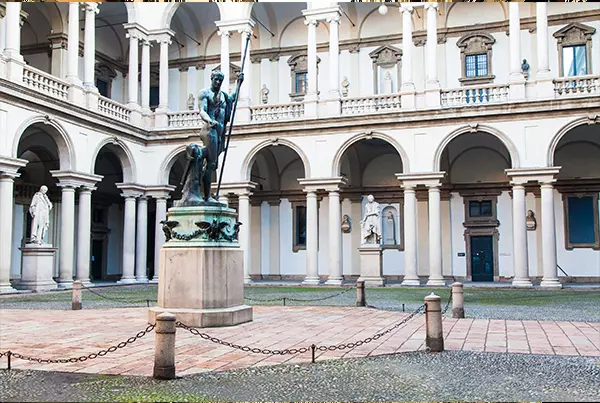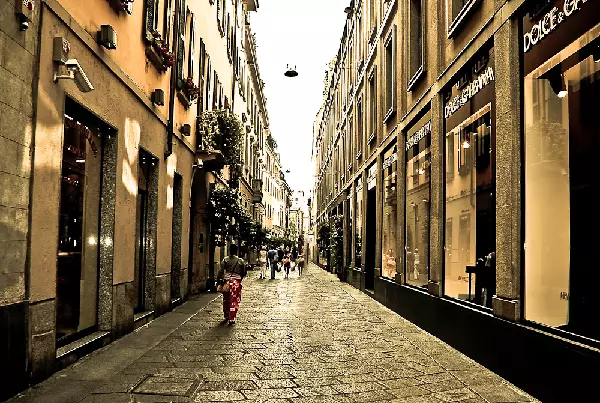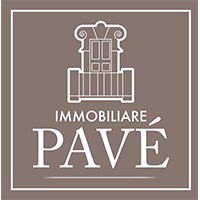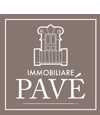Brera
The past of the Braida
Under Lombard influence, the Brera district was mainly a large avenue made of scrub and prickly brambles, a popularly defined urban area Braida, that haunted the Milanese center; over time, being very close to the city center, this place was increasingly inhabited, becoming in a short time from a peripheral district to a centralized area. Braida became Brera and from that day on, both the street and its namesake building took this name. From the 1200s to the late 1500s it was inhabited by the Umiliati, a religious order recognized by Pope Innocent III and mainly dedicated to the processing of wool. The order was then abolished in 1571 with the papal bull of Papa Pio V; shortly after and by the Order of Jesus, (Clerical Constitution founded by Ignatius of Loyola), the building still under construction (the entire facade was missing), was assigned to their male college, which lasted until 1773, the year in which The Compagnia di Gesù it was officially suppressed. Subsequently, thanks to the commitment and dedication of the architect Giuseppe Piermarini commissioned by Maria Theresa of Austria, in 1795 the building was finally finished and became the most important building for Milan used as a place of culture. From the beginning of the 19th century and up to the middle of the 20th century, passing through disputes between sovereigns and political forces, between two world wars and various structural ups and downs, the building reaches the end of the 20th century, more alive than ever and steeped in history as well as a cultural cradle and training of countless illustrious personalities including: Adolfo Wildt, Lucio Fontana, Fausto Melotti, Liliana Moro, Mario Airò, Gianni Caravaggio, Bernhard Rüdiger, Marcello Maloberti, Vanessa Beecroft, Lara Favaretto, Giuseppe Gabellone, Paola Pivi, Roberto Cuoghi, Petrit Halilaj just to name a few.

The present between design and its cultural heritage
But what is Brera like now? And why is it so prestigious to have a residence here? First of all, it should be emphasized that the Brera area is nicknamed the: “Design District”, this name is given due to the presence of the high concentration of Interior design showrooms, especially of well-known international brands. Furthermore, for Italy, it represents the High shopping pole of its sector, the country’s most illustrious and not surprisingly it is a destination for elite tourism from all parts of the world. Also boasts important cultural fulcrum of the city: The Astronomical Observatory established in 1764, sponsored by INAF (National Institute of Astrophysics) and recognized worldwide. TheBotanical Garden from 1774, born as an educational space for medical students and over the centuries it has become one of the major attractions of the Palazzo Storico; in its silent and suggestive spaces over 200 species of plants are preserved including Ginkgo biloba, one of the oldest plants in the world and dating back to 250 million years ago. L’Academia delle Belle Arti officially established in 1776, an authentic landmark of historical culture and to this day a sought-after destination for artists and aspiring artists who want to pursue a prestigious artistic career. The Pinacoteca, founded in 1809 and historical treasure chest of many works by illustrious personalities such as: Raphael, Caravaggio, Tintoretto, Piero della Francesca…, works of inestimable value that can only be admired in this place. But Brera, in addition to its illustrious history, offers much more: streets full of shops, eclectic clubs, markets, high-level restaurants and a few steps away you arrive in the city center: Teatro alla Scala, via Montenapoleone and Milan Cathedral.

Evolution and the Braidense Library
The Brera area, which over the centuries has been increasingly structured, has undergone some urban renovations but has maintained its epicenter in Via Brera where at number 28 you can still visit the well-known historic building. The neighborhood continues on via Pontaccio, extending all the way to via Mercato, via Ponte Vetero, via Giardini and via Madonnina. This Milanese area gives glimpses of autochthonous history and with its original buildings on numerous adjacent streets, it gives us a nice set of Milan of the “times that were”; Ancient buildings mix with the most recent ones, rebuilt and built in the economic recovery after the bombings of the Second World War. We arrive in the 1950s, the neighborhood in full post-war turmoil becomes a place of artistic genesis for many young people, who here fully expressed their creativity. For those wishing to deepen the life of that period, we invite you to read the novel: “La vita Agra” by Luciano Bianciardi, in the first chapters of his book, gives an excellent insight into the neighborhood life of those years. Journalists, literary critics, intellectuals and lovers of Milanese history have written and published several books on Brera, many of which can be found in the Braidense Library dating back to the 1700s and owned by the state. The library is located in via Brera 28 inside the historic building, and in 2013 the Lombard historical society has brought its headquarters here; among his countless books he also boasts an excellent catalog of digital volumes.

Click on the![]() placeholders on the map to see the corresponding residence in the Brera district.
placeholders on the map to see the corresponding residence in the Brera district.
Search for a residence, entering one or more parameters that are priority for you
Residences in Brera
Moscova Ad.
- €1.790.000
- Letti: 4
- Idromassaggi: 2
- 195 m²
Entrust your property to experienced professionals
Selling real estate can be a long process. Reduce your selling time by relying on our experience.


